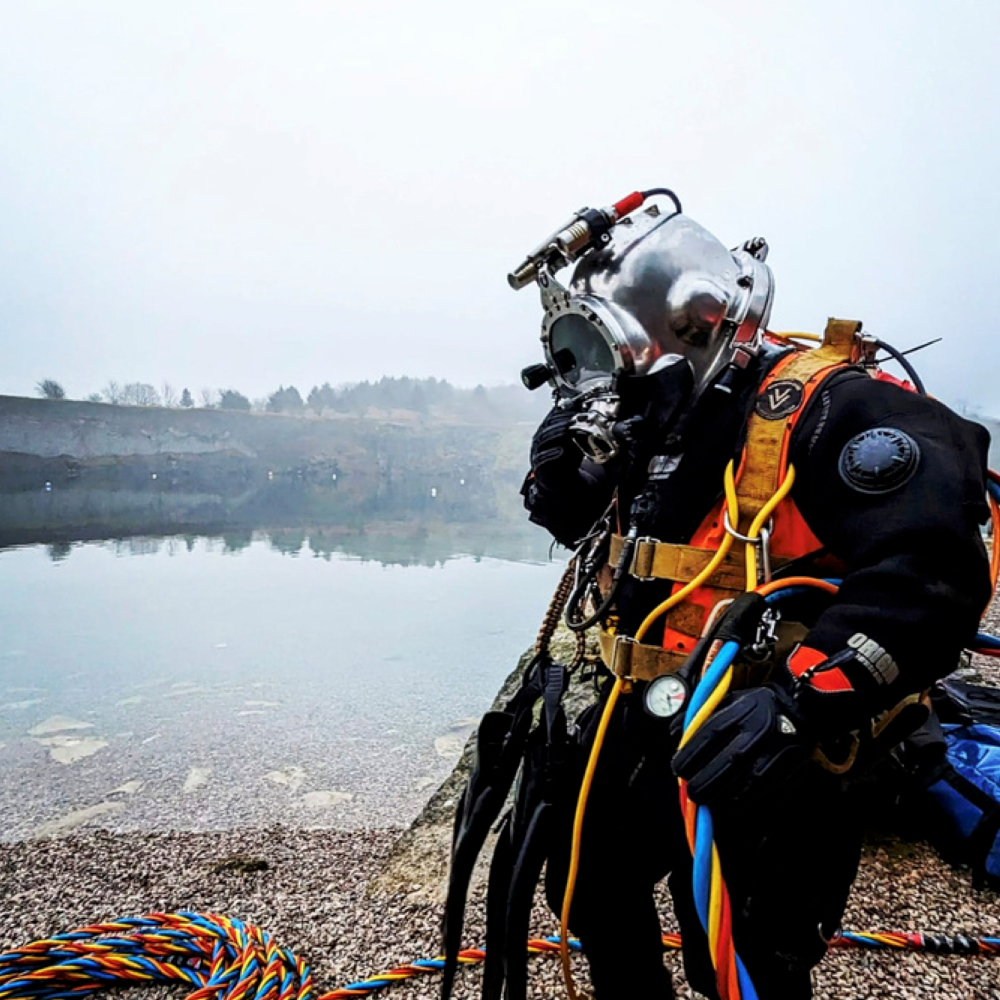Commercial diving operations involve complex procedures, specialised equipment, and critical safety protocols. All of this can be daunting if you’re looking to hire a dive team, and while we take great care in explaining our methods and protocols in our dive plan (see D!), a reference point for diving terminology can give clients that added bit of confidence.
This glossary breaks down the essential terms and acronyms you need to understand our industry using clear, complete explanations.
A
ADS (Atmospheric Diving Suit) (Equipment)
An Atmospheric Diving Suit is a hard-shell diving suit that maintains atmospheric pressure around the diver. This equipment enables work at extreme depths without requiring decompression and serves as an essential piece of kit for deep water operations.
Air Lift (Operational Procedure)
Air lifting is a method of moving sediment and debris that uses compressed air to create suction. This technique provides an efficient underwater digging method for excavation work.
Air Diving Capability (Technical Term)
Air diving capability relates to surface-supplied air system operations. Commercial diving operations typically use compressed air rather than mixed gas systems as their standard approach.
Ambient Pressure (Technical Term)
Ambient pressure refers to the water pressure at depth. This pressure increases by one atmosphere (14.7 psi) for every 10 metres of depth, representing fundamental physics that every diver must understand.
Anoxic (Safety Term)
Anoxic describes an environment with little or zero oxygen present. These conditions are potentially lethal and require immediate emergency response procedures.
B
Bailout (Safety Equipment)
A bailout system provides emergency breathing gas backup for divers. Every diver relies on this equipment as their lifeline when primary breathing systems fail.
Bell Diving (Operational Procedure)
Bell diving uses a diving bell chamber transport system that maintains pressure whilst moving divers to the worksite. This method serves as the standard approach for deeper operations.
Bottom Time (Technical Term)
Bottom time represents the total underwater working time per dive. This measurement is critical for both decompression planning and operational efficiency calculations.
Buoyancy (Technical Term)
Buoyancy is the upward water force that opposes the weight of submerged objects. This physics principle controls diver movement and equipment handling underwater.
C
Caisson (Equipment)
A caisson is a watertight construction chamber designed for underwater work. This structure creates a dry working environment below water level for construction activities.
Chamber (Decompression) (Safety Equipment)
A decompression chamber is a pressurised treatment vessel used for treating decompression sickness. This equipment serves as essential safety equipment for all commercial diving operations. Find out more about decompression chamber use in our FAQs.
Cofferdam (Equipment)
A cofferdam is a temporary watertight enclosure that creates a dry workspace in water. This standard construction technique is commonly used for marine projects.
Contaminated Water Diving (Operational Procedure)
Contaminated water diving involves operations in polluted, chemical, or biologically hazardous water. These operations require specialist protective equipment and specific safety procedures.
CSWIP (Certification Scheme for Welding and Inspection Personnel) (Industry Standard)
CSWIP is a UK welding certification body that validates underwater welding specialists. This organisation provides the industry gold standard for welding certification.
D
DCI (Decompression Illness) (Safety Acronym)
Decompression Illness, commonly known as “the bends”, occurs when nitrogen bubbles form in body tissue due to ascending too quickly. This condition is classified as a medical emergency that requires immediate recompression treatment.
Decompression (Operational Procedure)
Decompression is the controlled pressure reduction process during ascent that prevents the bends. The time required for decompression serves as a non-negotiable safety protocol for any type of diving and is factored into all dive plans.
Dive Plan (Operational Procedure)
A dive plan is a detailed operational blueprint that covers objectives, safety procedures, and emergency protocols. No dive operation proceeds without a comprehensive dive plan.
Dive Supervisor (Personnel Role)
A dive supervisor is a qualified person who commands diving operations. The dive supervisor holds ultimate responsibility for diver safety and project execution. Find out more about how many divers are needed for each project in our FAQs.
DSV (Diving Support Vessel) (Equipment)
A Diving Support Vessel is a purpose-built ship equipped with chambers, life support systems, and specialist equipment. These vessels are specifically designed to support commercial diving operations.
E
EGS (Emergency Gas Supply) (Safety Equipment)
An Emergency Gas Supply is a backup breathing system that activates when the primary supply fails. This equipment is mandatory for diving operations.
EOD (Explosive Ordnance Disposal) (Safety Acronym)
Explosive Ordnance Disposal is the specialist process of detecting, evaluating, and disposing of explosive devices. These operations require trained personnel and strict safety protocols.
Excursion Diving (Operational Procedure)
Excursion diving involves operations that exceed normal depth limits. These operations require special decompression procedures and enhanced safety measures.
F
FEA (Finite Element Analysis) (Technical Term)
Finite Element Analysis is a computer simulation technique that analyses the structural integrity of underwater installations. This engineering tool is essential for complex underwater projects.
Free-Flooding (Technical Term)
Free-flooding describes equipment that is designed to fill with water rather than maintain air spaces. This design approach is standard for certain underwater applications, such as ballast tanks and pipeline protective systems.
G
Gas Mixing (Operational Procedure)
Gas mixing is the process of blending oxygen, nitrogen, and helium to create specific breathing mixtures for different depths. This technical skill is essential for deep diving operations.
Guardrail (Safety Equipment)
A guardrail is a safety barrier that prevents falls and provides underwater guidance. These barriers serve as standard protection for elevated work areas.
H
HAT (Height Above Touchdown) (Technical Term)
Height Above Touchdown is the measurement from the seabed to a platform structure. This critical dimension is essential for offshore operations planning.
Heliox (Technical Term)
Heliox is a helium-oxygen breathing mixture used for deep diving operations. This gas mixture prevents nitrogen narcosis at extreme depths.
Hot Work (Operational Procedure)
Hot work encompasses underwater welding, cutting, or any heat-producing operations. These activities require specialist safety procedures and fire prevention measures.
I
IMCA (International Marine Contractors Association) (Industry Standard)
The International Marine Contractors Association is a global marine industry body that provides operational standards and guidance. IMCA serves as the industry benchmark for safety procedures and operational standards.
Inspection Class (Technical Term)
Inspection class is an underwater inspection detail and reporting classification system. This system defines the scope and requirements for structural assessments. This might be a GVI (General Visual Inspection) or CVI (Close Visual Inspection) for a ship hull inspection, for example.
Isolator Valve (Safety Equipment)
An isolator valve is an emergency gas supply shut-off valve designed for individual divers. This component serves as critical safety equipment for multi-diver operations.
J
Jetting (Operational Procedure)
Jetting is a high-pressure water technique used for excavation, cleaning, and cutting operations. This method provides an efficient approach for underwater material removal.
Jumper (Equipment)
A jumper is a flexible pipeline connection that links underwater equipment together. These components serve as standard elements for subsea installations.
K
Kevlar (Equipment)
Kevlar is a high-strength synthetic material used in umbilicals and safety equipment. This material is exceptionally durability and cut resistance.
L
Life Support System (Safety Equipment)
A life support system is a complete breathing gas, communications, and emergency backup system. This equipment represents fundamental safety equipment for surface-supplied diving operations.
Lifting Bag (Equipment)
A lifting bag is an inflatable buoyancy device used for raising objects from the seabed. These devices serve as essential recovery tools for marine operations.
LST (Life Support Technician) (Personnel Role)
A Life Support Technician is a qualified operator who monitors diver life support equipment. This critical surface support role ensures diver safety throughout operations.
M
Mixed Gas (Technical Term)
Mixed gas refers to breathing gas combinations beyond standard air, including nitrox, trimix, and heliox. These gas mixtures are required for specific depth and duration operations.
MOU (Memorandum of Understanding) (Regulatory Term)
A Memorandum of Understanding is a formal project agreement that outlines responsibilities, procedures, and safety protocols. This document provides the legal framework for diving operations.
Mud Mat (Equipment)
A mud mat is a seabed foundation that protects against scour and supports heavy equipment. These structures provide standard protection for subsea installations.
N
NDT (Non-Destructive Testing) (Technical Term)
Non-Destructive Testing is a method of inspecting materials and structures without causing damage. This technique is essential for quality control of underwater installations.
Nitrox (Technical Term)
Nitrox is an oxygen-enriched breathing gas mixture that extends bottom time and reduces decompression requirements. This gas mixture is commonly used in commercial diving operations.
No-Decompression Limit (Safety Term)
The no-decompression limit is the maximum depth and time combination that can be achieved without requiring decompression stops. This represents a critical safety parameter for dive planning.
O
Oxygen Toxicity (Safety Term)
Oxygen toxicity is a dangerous condition that results from high-pressure oxygen exposure. This potentially fatal condition requires strict gas management protocols to prevent occurrence.
Overboard Discharge (Operational Procedure)
Overboard discharge is the planned release of materials from a vessel during operations. These activities require environmental compliance and specific safety procedures.
P
Penetration Diving (Operational Procedure)
Also known as confined-spaces diving, penetration diving involves operations inside enclosed spaces such as ship holds, tanks, and pipelines. This high-risk environment requires specialist procedures and equipment.
POB (Persons on Board) (Safety Acronym)
Persons on Board represents the total personnel count on a vessel or platform. This information is essential for emergency response and safety management procedures.
PUXO (Potential Unexploded Ordnance) (Safety Acronym)
Potential Unexploded Ordnance refers to military munitions that are potentially unexploded and dangerous. These items include historical artillery, bombs, and naval mines that require expert handling.
Pneumofathometer (Equipment)
A pneumofathometer is a pressure-change depth measurement instrument that provides accurate depth determination for diving operations. This tool ensures precise depth measurements during underwater work.
Q
QA/QC (Quality Assurance/Quality Control) (Industry Standard)
Quality Assurance and Quality Control are systematic processes that ensure work meets specified standards. These procedures represent non-negotiable requirements for professional diving operations.
Quayside (Technical Term)
Quayside refers to a wharf or pier adjacent mooring area where vessels position themselves. This location serves as the standard vessel positioning area for marine operations.
R
ROV (Remotely Operated Vehicle) (Equipment)
A Remotely Operated Vehicle is a surface-controlled unmanned submersible used for inspection, survey, and light construction work. ROVs extend operational capability beyond what divers can achieve alone.
Recompression (Safety Procedure)
Recompression is the treatment for decompression sickness that returns the patient to higher pressure conditions. This emergency medical procedure uses hyperbaric chambers to treat diving-related injuries.
RIDDOR (Reporting of Injuries, Diseases and Dangerous Occurrences Regulations) (Regulatory Term)
RIDDOR is UK legislation that requires reporting of serious workplace incidents. This represents a legal requirement for commercial diving operations.
S
Saturation Diving (Operational Procedure)
Saturation diving involves extended depth operations where divers live in pressurised chambers between work periods. This technique is used for long-duration deep water projects.
Standby Diver (Personnel Role)
A standby diver is a fully equipped emergency response diver who remains ready for immediate deployment. This position represents a mandatory safety requirement for all diving operations.
Surface-Supplied Diving (Operational Procedure)
Surface-supplied diving is a method where breathing gas is supplied through an umbilical from surface equipment. This approach serves as the standard method for commercial diving operations. See why we use SSD and not scuba.
SSDE (Surface-Supplied Diving Equipment) (Equipment)
Surface-Supplied Diving Equipment represents the complete surface-based system that provides breathing gas, communications, and safety monitoring. This equipment forms the fundamental setup for commercial diving operations.
T
TI (Target Investigation) (Operational Procedure)
Target Investigation is the systematic underwater examination of detected objects or anomalies. This process determines the nature, condition, and potential hazards through direct diver assessment.
Tender (Personnel Role)
A tender is the surface support person who manages the diver’s umbilical and communications. This critical support role ensures diver safety and operational efficiency throughout the dive.
Trimix (Technical Term)
Trimix is an oxygen, nitrogen, and helium breathing mixture designed for deep operations. This gas mixture prevents both nitrogen narcosis and oxygen toxicity at extreme depths.
TUP (Temporarily Unused Pipeline) (Technical Term)
A Temporarily Unused Pipeline is a pipeline system that is not currently operational but is maintained for future use. These systems require periodic inspection and maintenance to ensure readiness.
U
Umbilical (Equipment)
An umbilical is the diver’s lifeline that carries breathing gas, power, and communications from the surface. This fundamental connection enables surface-supplied diving operations.
Underwater Welding (Operational Procedure)
Underwater welding is specialist welding performed underwater using either wet welding or dry chamber welding techniques. This work requires advanced certification and specialised equipment.
UWILD (Underwater Inspection in Lieu of Dry-Docking) (Operational Procedure)
Underwater Inspection in Lieu of Dry-Docking is an in-water vessel survey that avoids dry dock costs and time. This process assesses hull condition, propellers, and underwater fittings whilst the vessel remains operational.
UXO (Unexploded Ordnance) (Safety Acronym)
Unexploded Ordnance refers to military explosives that failed to detonate and remain potentially dangerous. These items require specialist EOD procedures and qualified personnel for safe handling.
V
Venturi Effect (Technical Term)
The Venturi Effect is a gas flow principle that creates suction and is used in various diving equipment. This physics principle is applied in multiple diving systems to enhance functionality.
Visibility (Technical Term)
Visibility is the underwater visual range measured in metres. This factor is critical for dive planning, safety procedures, and operational efficiency assessment.
W
Water Jetting (Operational Procedure)
Water jetting is a high-pressure water technique used for cleaning, cutting, and excavation. This method provides efficient underwater material removal and surface preparation capabilities.
Wet Bell (Equipment)
A wet bell is an open-bottom diving chamber that maintains an air space underwater while allowing diver access. This equipment serves as an intermediate system between surface supply and saturation diving.
Working Depth (Technical Term)
Working depth is the depth at which diving operations are conducted. This measurement determines equipment requirements, operational procedures, and safety protocols for each dive.
X
X-Ray Testing (Technical Term)
X-ray testing is a radiographic method for inspecting weld and structural integrity. This non-destructive testing method is essential for quality assurance in underwater installations.
Y
Yield Strength (Technical Term)
Yield strength is the maximum stress a material can withstand before permanent deformation occurs. This critical engineering parameter is essential for structural design and safety factor calculations.
Z
Zero Visibility (Safety Term)
Zero visibility describes diving conditions with no visual range whatsoever. These conditions require special procedures, enhanced safety protocols, and specialist equipment to ensure safe operations.
Still have questions?
Email our Managing Director Dan at daniel@daggerdivingservices.co.uk who would be happy to answer them, or take a look at our FAQs.




Leave A Comment
You must be logged in to post a comment.